Manage a Portal
A Portal Admin or the Platform Owner/Staff can both manage a Portal.
The main areas to Manage a Portal are :
- Branding (white-labeling)
- Access (user & content)
- Admins
- Learners
- Sub-Portals
- Announcements
- eCommerce (orders, subscriptions)
- Others
Managing/Updating Portal
Steps for updating/managing a Portal
- In the Dashboard go to Portals ->All Portals.
- Find the portal you want to manage, and click on (...) in the Actions Column.
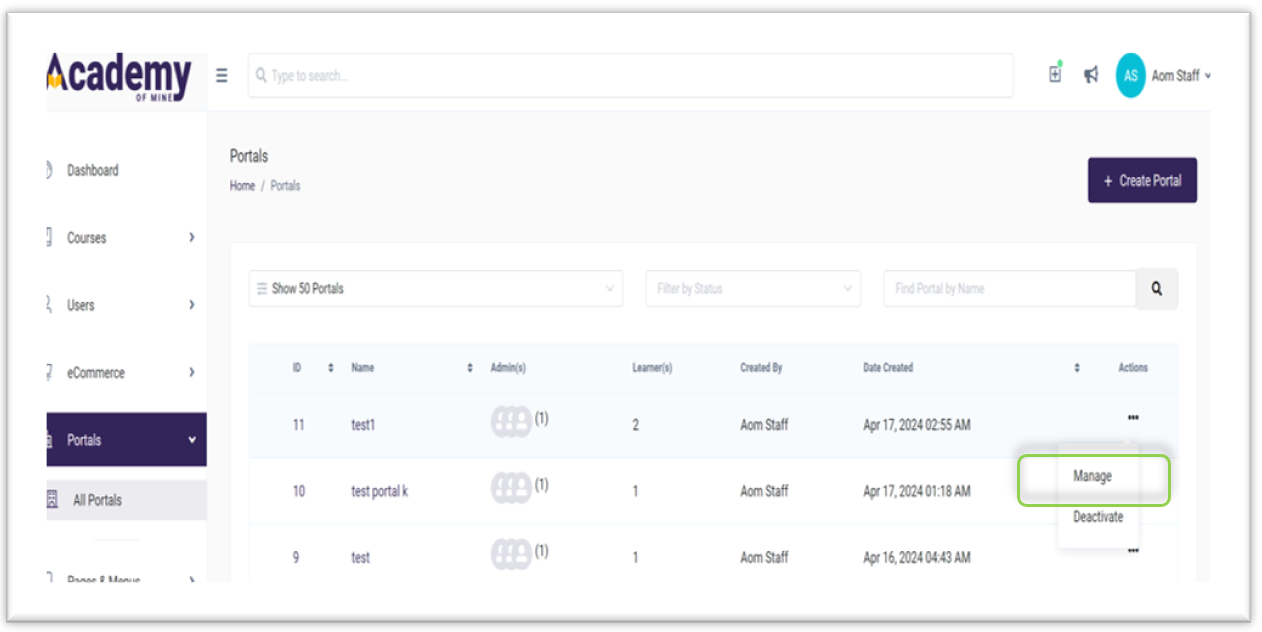
- Click on Manage
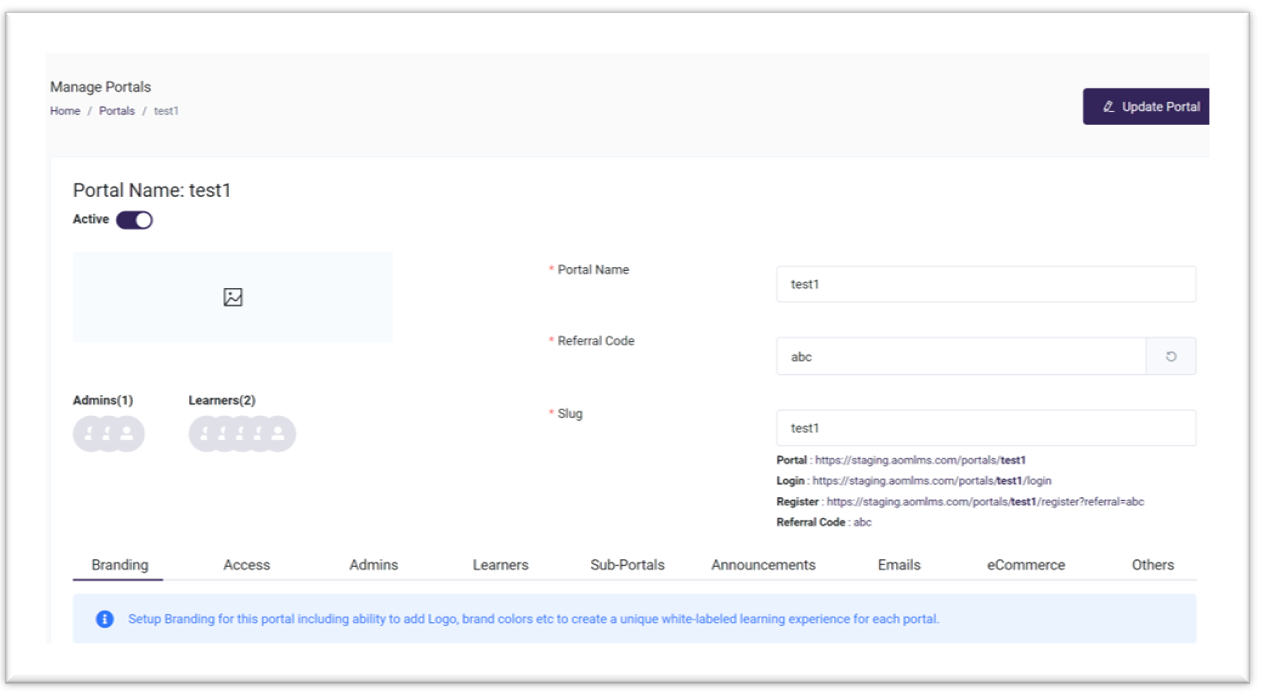
- Here we can edit Portal Name, Referral Code and Slug .
- On navigating to the different tabs, you will be able to add the respective setting/functionality to the particular Portal.
- Branding
- Access
- Admins
- Learners
- Sub-Portals
- Announcements
- Emails
- eCommerce
- Others
Branding
A Portal Admin and Admin of the platform can setup the Branding for this portal. Logo, brand colors, and other styling can be customized to create a unique white-labeled learning experience for each portal.
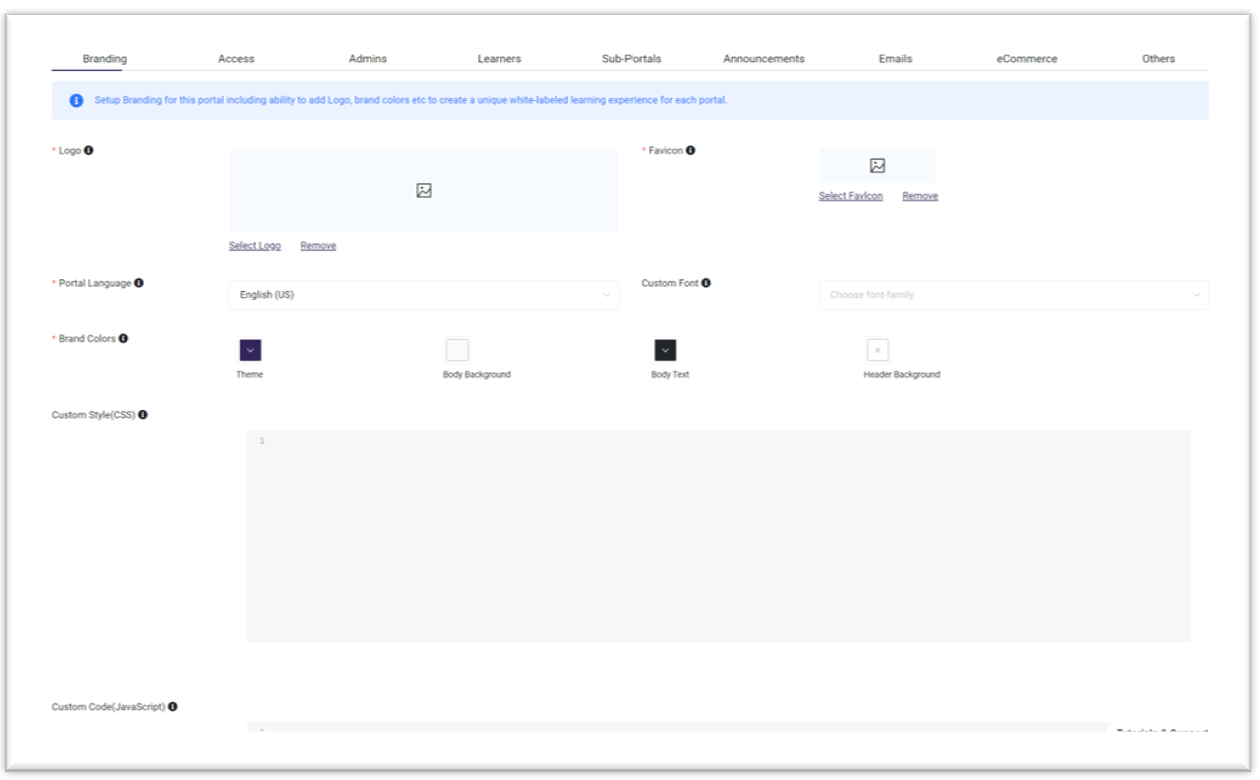
- Logo: Logo is displayed to portal user and in related portal emails.
- Favicon: Upload the favicon here and it will be displayed in the address bar of the browser.
- Portal Language: Set the default language for the portal.
- Custom Font: Can select Custom font for the portal.
- Brand Colors: Customize Portal color theme by setting Theme, Body Background, Body text. Header Background
- Custom Style (CSS): To add custom styling using CSS to further change look and feel of the portal.
- Custom Code (JavaScript): The feature is typically for adding 3rd party code like Google analytics etc.,
Click here to learn more on how to add branding and logo in a Portal.
Access
Enabling portal users to consume courses, classes, learning paths, and other learning resources. Guide on assigning access.
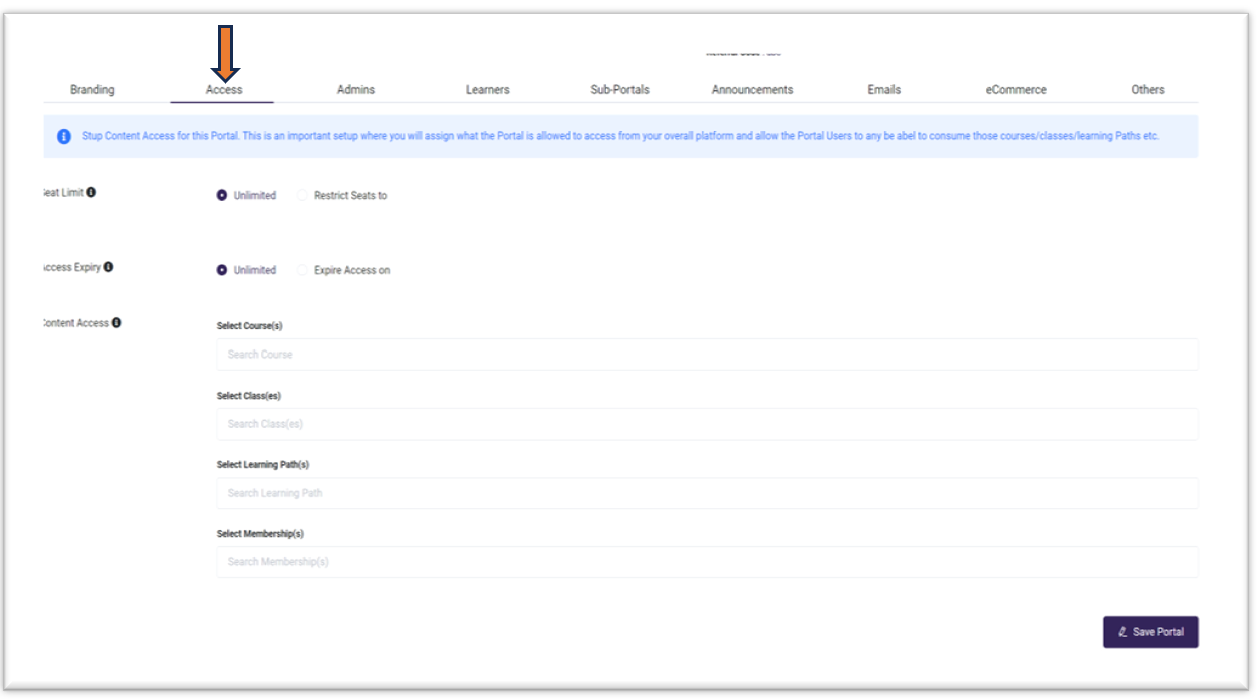
- Seat Limit: This key allows to set whether seats are restricted with a limit or can be allocated to unlimited users in the Portal. Leave it blank for unlimited access. Seat count includes the total of unique Learners.
- Access Expiry: This is to set expiry to the Portal on a certain date or keep it open-ended. once expires portal admin/users will not be able to access the portal.
- Content Access: Set portal access to Courses/Classes/Learning Paths/Membership.
Admins
The admins screen allows to view/add/remove/update admins for the given portal. Guide on adding portal admins.
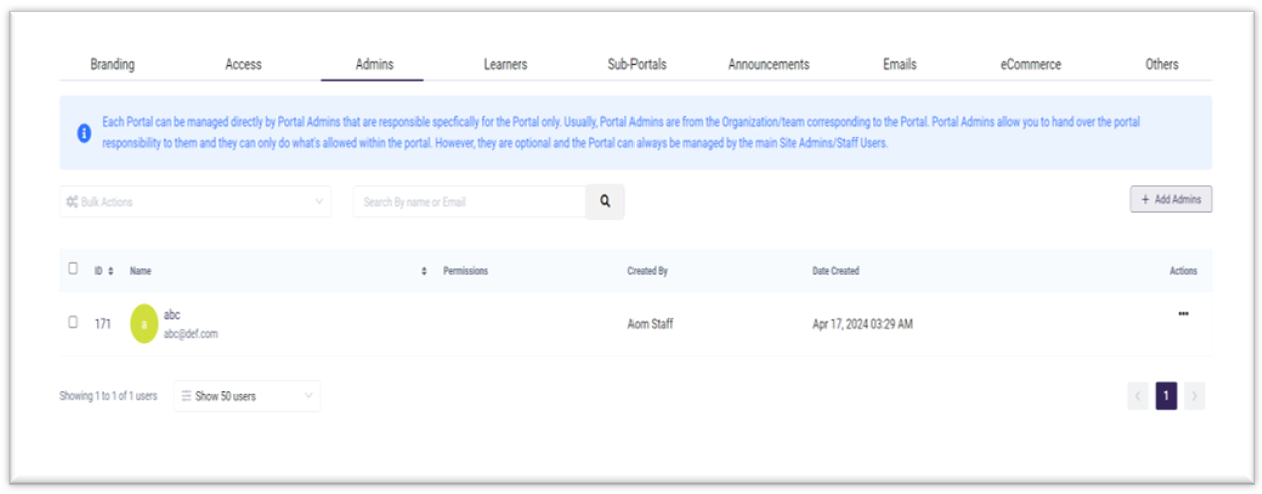
- Click on 'Add Admins'
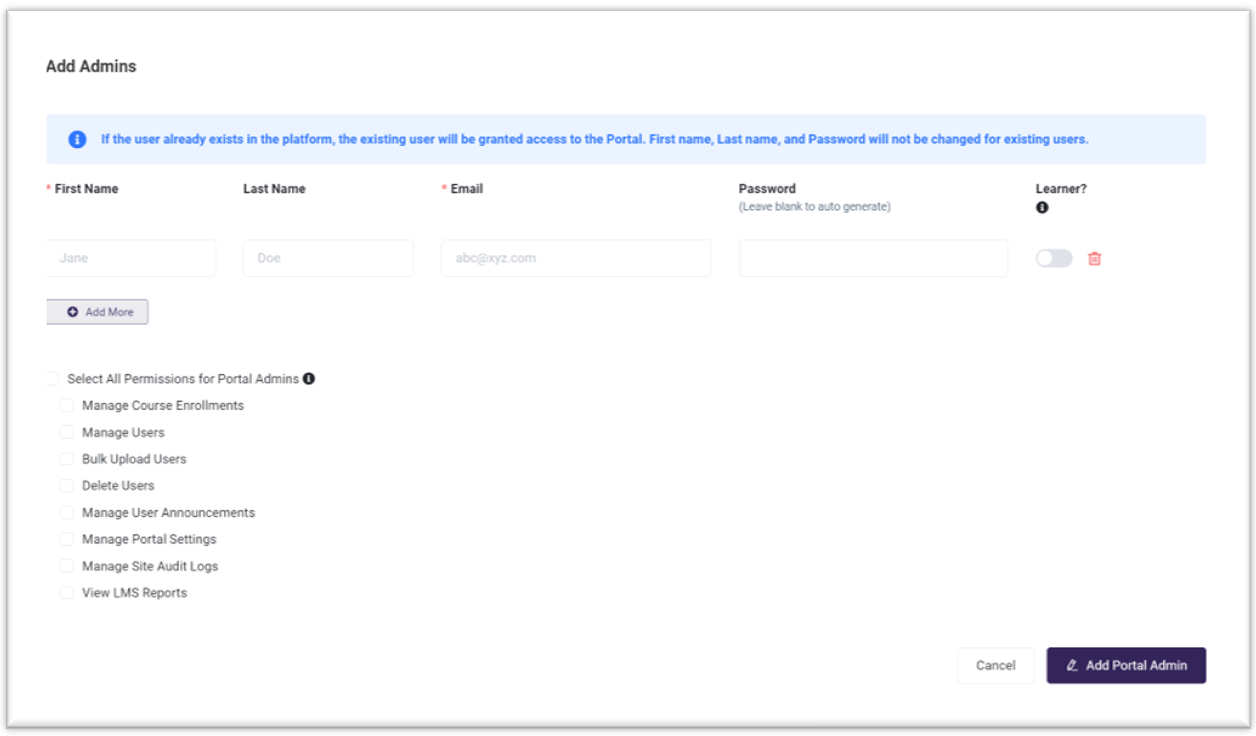
- First Name: Admin's first name.
- Last Name: Admin's last name (optional).
- Email: Admin's email address.
- Password: Leave blank if you want the password to be auto-generated.
- Learner? : By toggling this option, Portal Admin will allowed be learner as well in portal to take Courses etc., which will use a seat count if set.
- Click Add More to add additional admins.
- Configure permissions for the Portal Admins.
If you need to configure different permissions for each admin, you can edit permissions for each admin individually afterwards using the actions menu.
- Click on Add Portal Admin.
- Lastly, the following bulk actions are available: Reactivate / Suspend / Remove.
- Suspend: Locks the portal admin(s) out of the portal.
- Reactivate: Cancels the lock, allowing the portal admin(s) to access the portal.
- Remove: Removes the portal admin(s) from the portal.
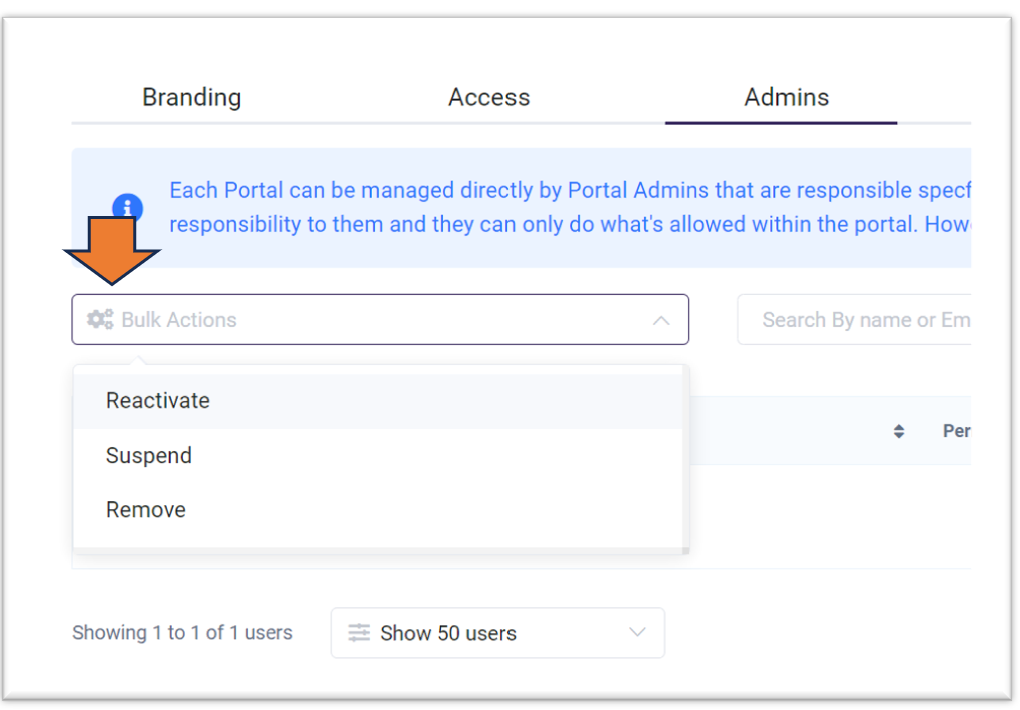
Learners
To create/manage/view learners for a Portal. Guide on adding a Learner.

- Click on Add Learners.
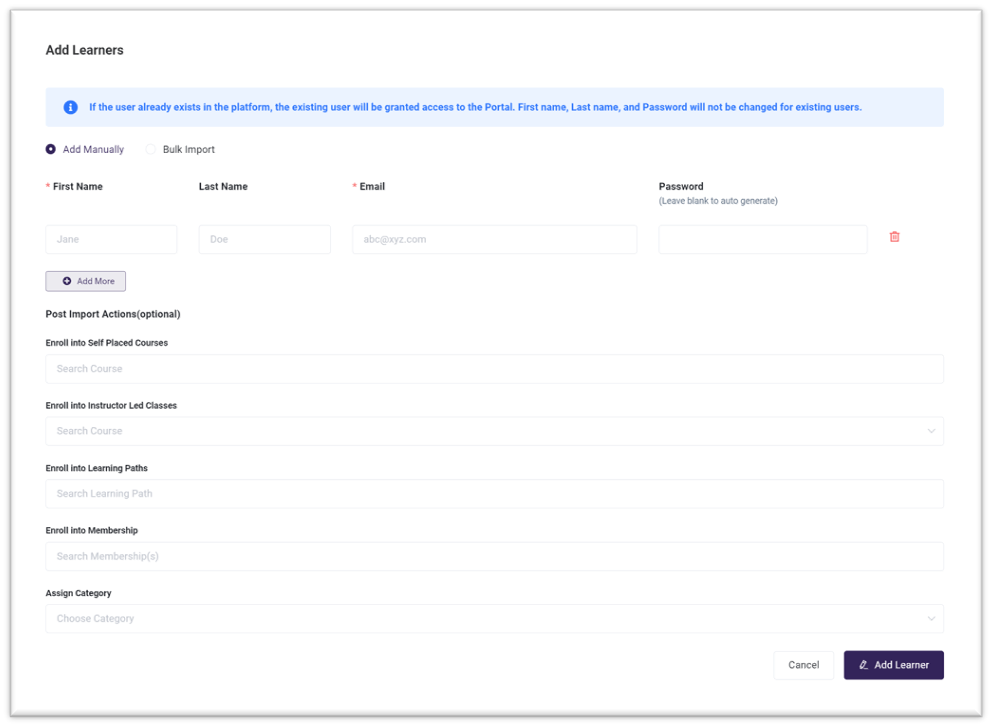
Adding learners manually
- First Name: Learner's first name.
- Last Name: Learner's last name (optional).
- Email: Learner's email address.
- Password: Leave blank if you want the password to be auto-generated.
- Click Add More to add additional learners.
Bulk importing learners
- In Learner tab click on the Bulk Import option.
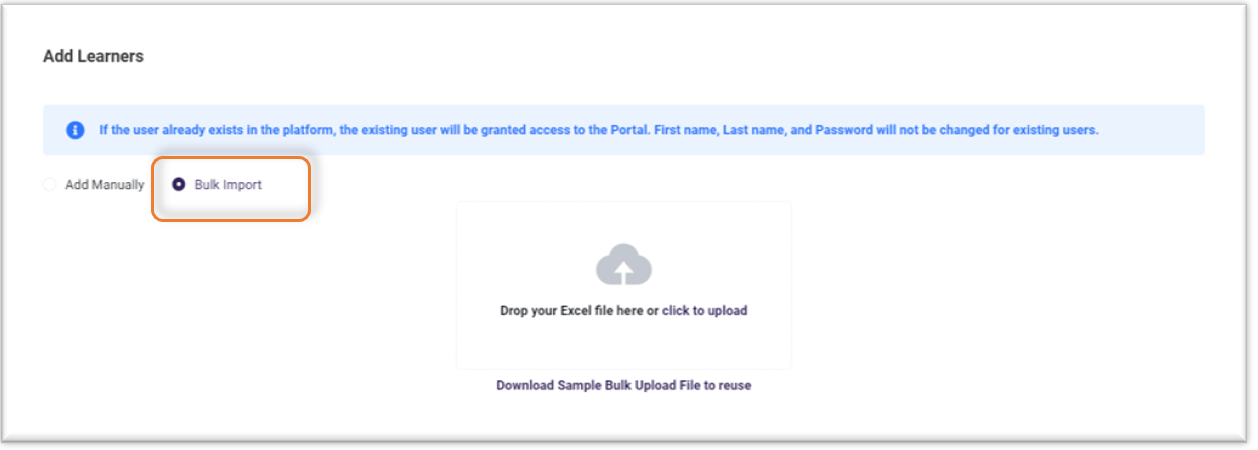
- Click on Download Sample Bulk Upload File to reuse.

- Fill in all the details in downloaded sample excel
- upload back the excel and click on 'Add Learners'
Sub Portals
Sub-Portals can be created only after a portal is Created. Sub-Portals will inherit the attributes from its parent Portal by default: Branding, Access, Admins, and Email.
- Click on 'Add Sub Portals'
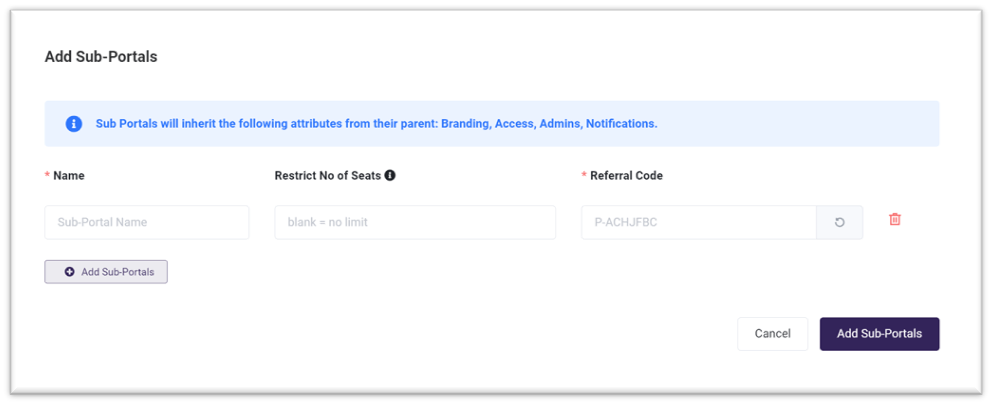
-
Name: Add the Sub Portal Name.
-
Restrict No of Seats: If Portal has a seat limit, then Sub Portal also must have a seat limit.
-
Referral Code: Referral Code to be filled.
-
Click on Add Sub-Portals.
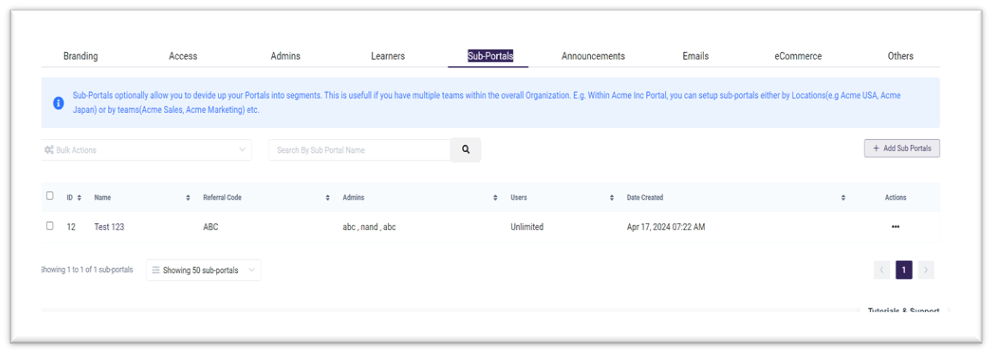
-
After adding Sub Portal, click on Manage if any changes are to be made in Access/Admin/Email.
Announcements
This section is to create Announcements and send them to Portals or Sub Portals users. To create an announcement fill in the following:
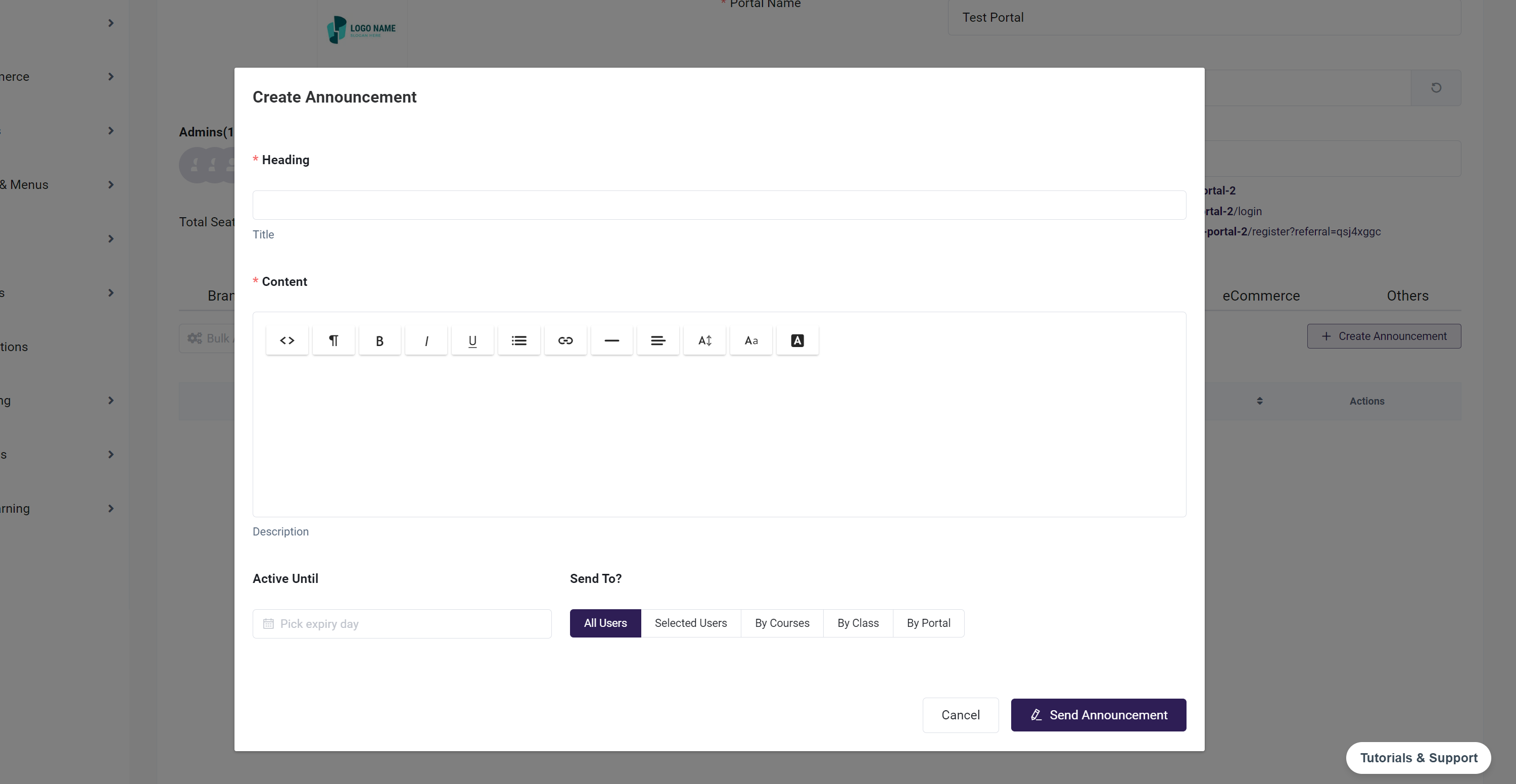
- Heading: Subject Of Announcement
- Content: Content of Announcement
- Active Until Set Expiry of Announcement.
- Send To?: Select the target audience from here.
- Then, Click on Send Announcement.
Emails
All LMS-related emails can be configured at a Portal level. By default, Portals will inherit their parent configurations; Portals will inherit platform settings and Sub-Portals will inherit Portal settings. Under email you have General. Accounts, LMS, Gamification, and Others menu to make changes accordingly
If no changes are made to the email templates, then they will follow the platform's standard email templates & settings.
General
General settings are to customize the look and feel of all emails sent through the platform.
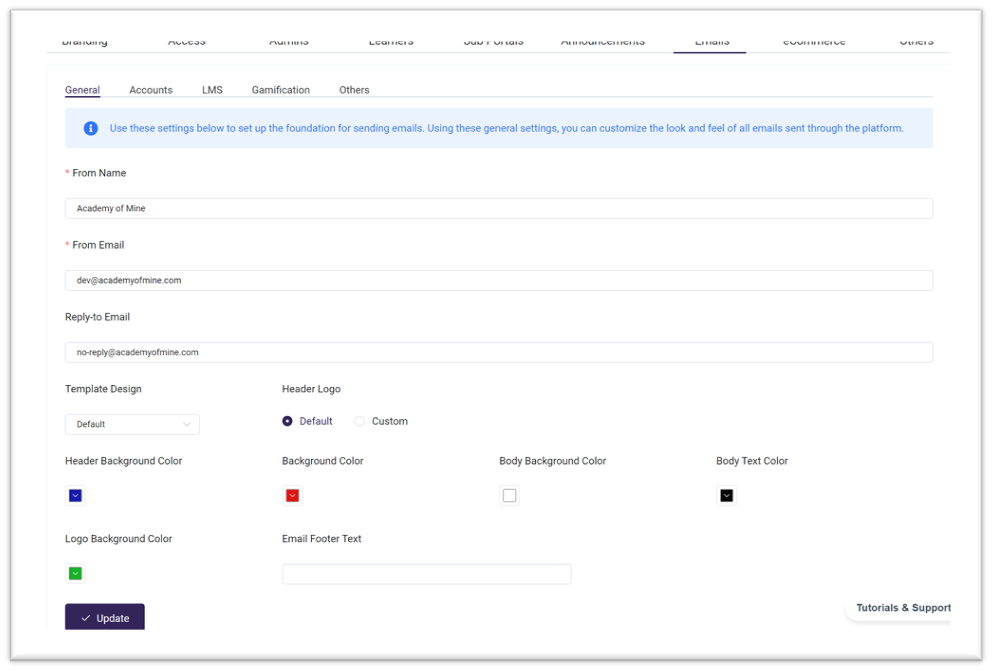
- From Name
- From Email
- Reply-to Email
- Template Design
- Header Logo
- Header Background Color
- Background Color
- Body Background Color
- Body Text Color
- Logo Background Color
- Email Footer Text
Guide on configuring automated email settings.
Accounts
A New Account email is sent to the user after an account is created for or by the user and generally should contain information such as Site URL, Username, and Password.

-
Click on Enable to enable Primary Recipient and fill in email details for Course Enrollmen.
-
CC/copy someone else (optional).
-
Subject of the email.
-
Email Heading: a heading within the email prior to the content.
-
Additional Content: body of the email.
-
Save Template to save email template changes.
-
Send a Test Email to test the email.
-
Click on Enable to enable Other Users to be notified.
-
Fill in all details like Recipient ID. Subject, Email heading, and Additional Content as required and update the template.
-
You can follow above steps for the Password Reset Request and Password Reset Success email templates too.
LMS
Email setting to notify students when they are Enrolled/Course completion/Quiz submission/Class enrollment etc., of a course.**
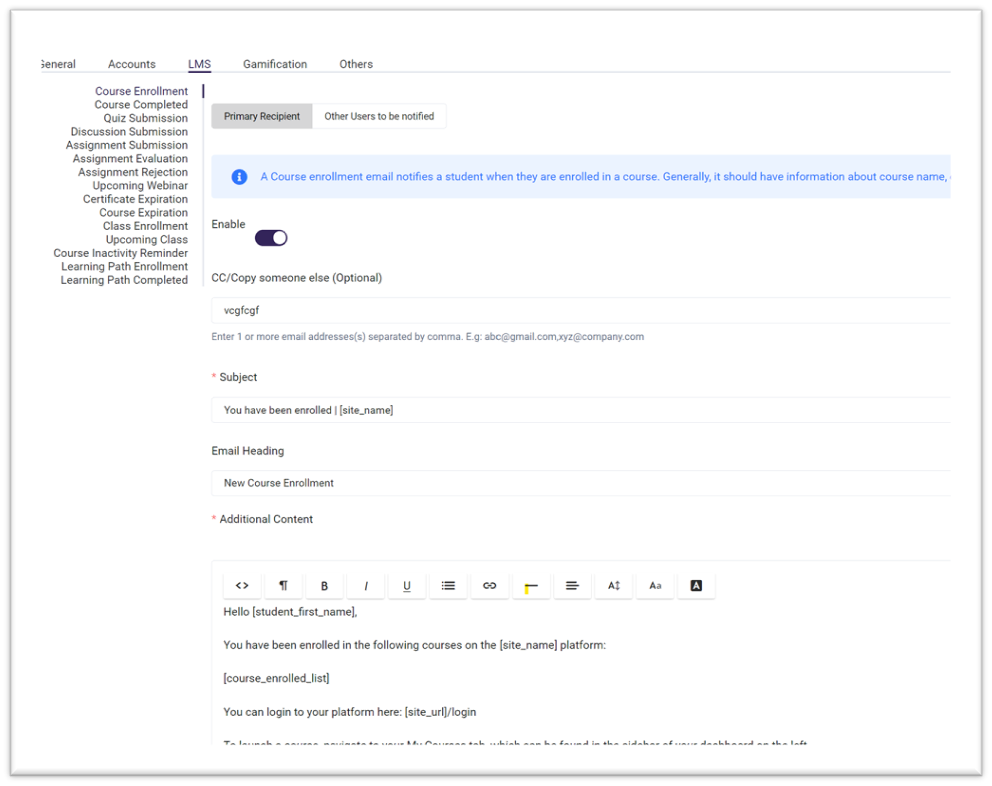
Here we have 15 activities for which emails can be configured. Activities like Course Enrollment, Course Completed, Quiz Submission, Discussion Submission, Assignment Submission, Assignment Evaluation, Assignment Rejection, Upcoming Webinar, Certificate Expiration, Course Expiration, Class Enrollment, Upcoming Class, Course Inactivity Reminder, Learning Path Enrollment, Learning Path Completed
-
Click on Enable to enable Primary Recipient and fill in email details for Course Enrollmen.
-
CC/copy someone else (optional).
-
Subject of the email.
-
Email Heading: a heading within the email prior to the content.
-
Additional Content: body of the email.
-
Save Template to save email template changes.
-
Send a Test Email to test the email.
-
Click on Enable to enable Other Users to be notified.
-
Fill in all details like Recipient ID. Subject, Email heading, and Additional Content as required and update the template.
-
You can follow above steps for updating the other email templates too.
Gamification
Email notifications can be set for users when they get a New badge, Leaderboard Promotion/Demotion tier in the platform.
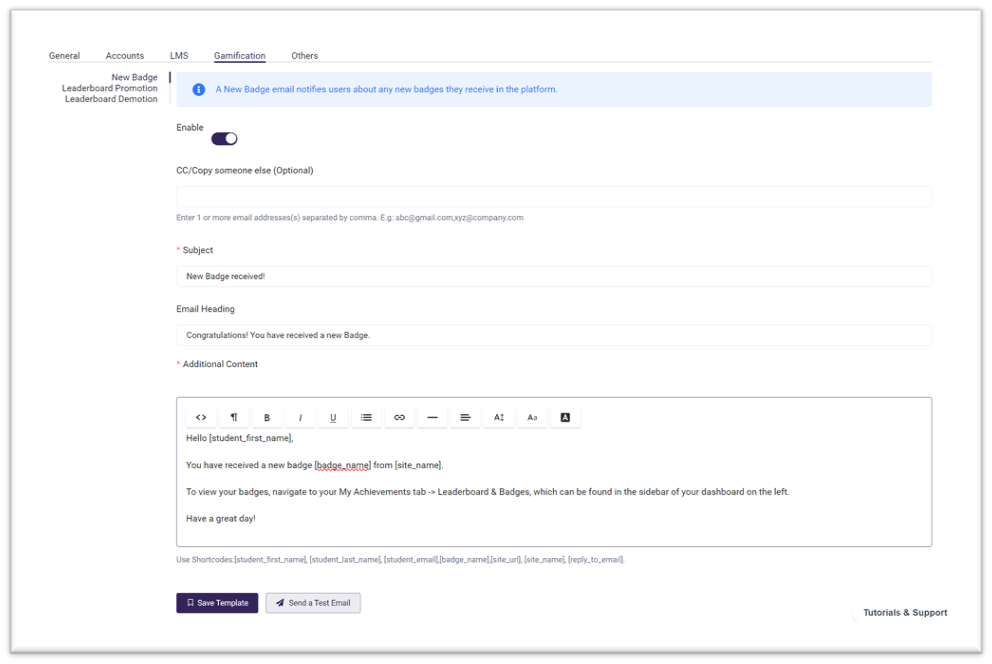
-
Click on Enable to enable Primary Recipient and fill in email details for Course Enrollmen.
-
CC/copy someone else (optional).
-
Subject of the email.
-
Email Heading: a heading within the email prior to the content.
-
Additional Content: body of the email.
-
Save Template to save email template changes.
-
Send a Test Email to test the email.
-
Click on Enable to enable Other Users to be notified.
-
Fill in all details like Recipient ID. Subject, Email heading, and Additional Content as required and update the template.
-
You can follow above steps for updating the other email templates too.
Others
Email notifications for Announcements can be set here.
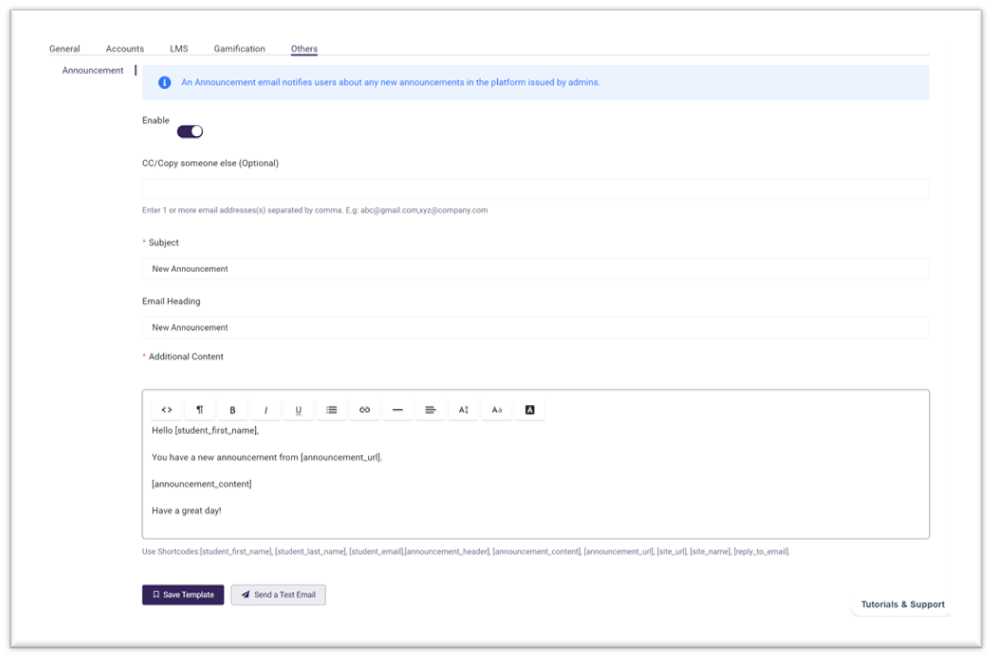
-
Click on Enable to enable Primary Recipient and fill in email details for Course Enrollmen.
-
CC/copy someone else (optional).
-
Subject of the email.
-
Email Heading: a heading within the email prior to the content.
-
Additional Content: body of the email.
-
Save Template to save email template changes.
-
Send a Test Email to test the email.
-
Fill in all details like Recipient ID. Subject, Email heading, and Additional Content as required and update the template.
E-Commerce
The E-commerce section has the details of the product purchased.
- Orders: Order details of the particular Portal will be listed.

- Subscriptions: If the purchased Product is of type 'Subscription', then the details of it will be listed.

Others
Under the other option you will be provided with a sub-tab that lists:
- Pages: Create pages that are specific to the particular portal. To know more on how to use the Page Builder you can click here.

- Menus: Can modify the sidebar menu for the "Portal Admin or Portal Learner" according to your requirements. To learn more on Customizing Menus click here.
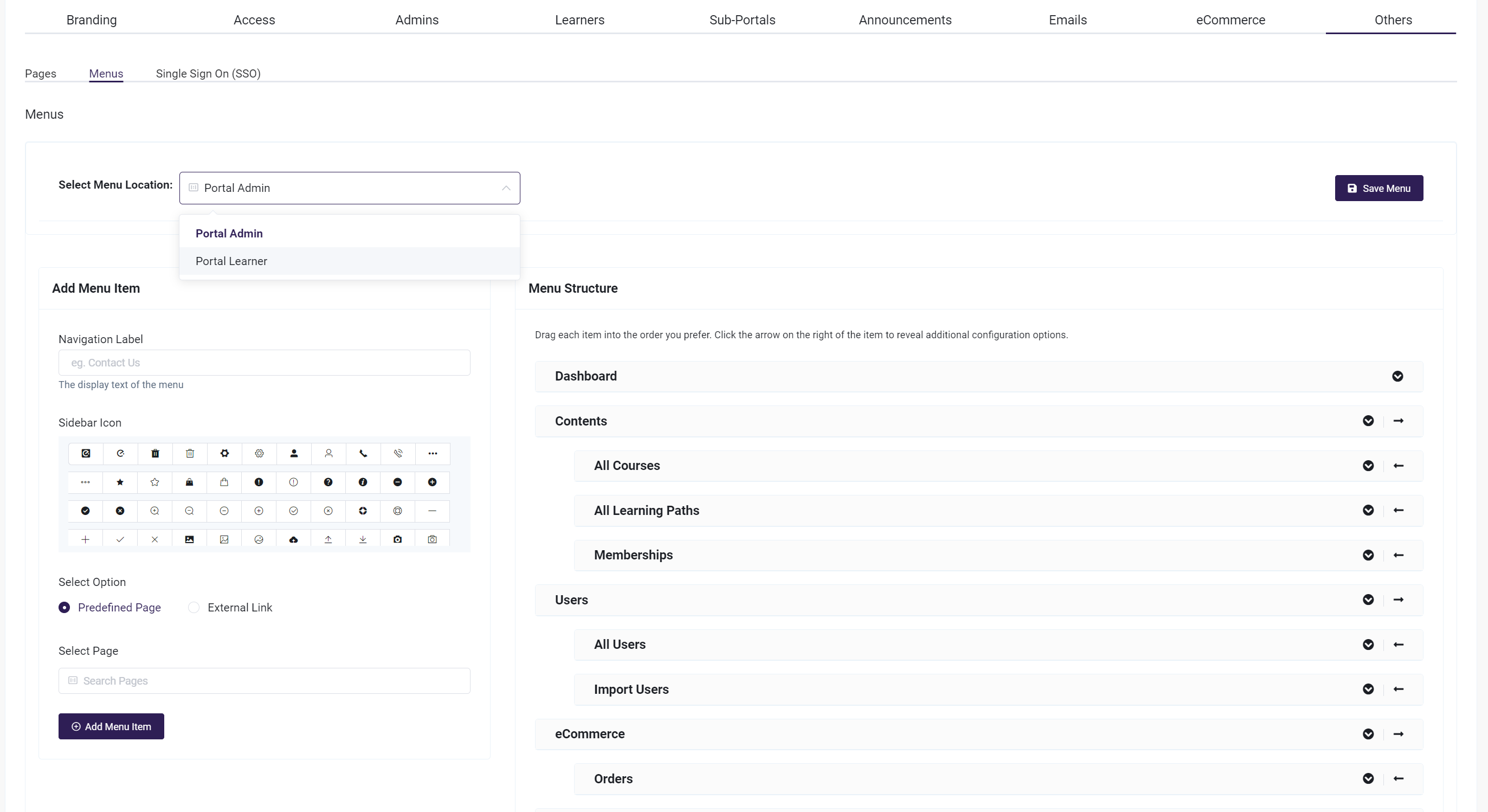
- Single Sign On (SSO): Coming soon.